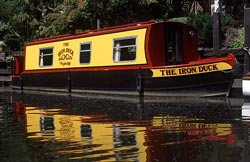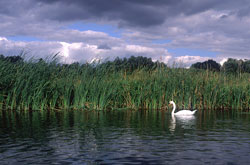Some of my photographic work on the River Thames involves making photographs from a kayak — a unique physical and visual balancing act guided by that time-honoured principle of simply messing about in boats. I like the closeness to subject matter this type of photography allows. You certainly cannot experience being on the river, short of being in the river, more intimately than from a kayak. How else could you drift amongst 50 swans dabbling at Kingston, inspect the marvelous brick torsional curves supporting Brunel’s railway bridge at Moulsford, or capture the full potential of a narrowboat’s vibrant colours reflecting in the river’s surface.
Kayak Photography?
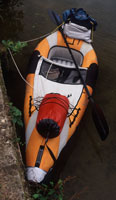 |
| Inflatable kayak loaded with gear |
How stable is a kayak for taking photographs? What I use is no ordinary kayak, but an inflatable kayak, with a somewhat flatter bottom than the regular craft and wider beam because of the air chambers either side. So it is surprisingly stable and good for waterborne photography. It is a professional craft made by the German manufacturer Stearns and consists of a precisely formed, dual-chambered heavy-duty inflatable bladder zipped into a kayak-shaped ‘jacket’ made of a heavy-guage woven nylon. It has two air chambers (inner diameter and outer) inflated with a foot pump in about five minutes via two valves mounted under flaps on the stern. For extra comfort, insulation and hull reinforcement there is a third inflatible chamber the size and shape of a stunted surfboard which slips into the bottom before inflation of the outer chambers.
Because the cockpit of the inflatable kayak has a skirt that zips back, it is reasonably easy to climb into. It also allows me more flexibility to turn this way and that and brace the camera for different images. This design also lets you pull your knees up if your legs are feeling a bit cramped. Where the open cockpit comes into its own, though, is during lunchtime. You can tie-up under an overhanging willow and stretch out for a floating picnic lunch. At that point when the sandwiches have been digested and you are well into some chunks of French dark chocolate (to build up energy reserves), you can lay your head back on the inflated stern of the kayak and extend your legs right out up on the bow. This wonderfully relaxing, prone position amazes fellow boaters and I have had entire motor yacht and narrowboat crews beaming, pointing and waving at me as they pass.
Danger: Angry Swan Ahead
Due to its stability, I have no experience of tipping out of the kayak so far. Entering the boat is a matter of sliding in feet-first and quickly getting as low and central as possible. Climbing out usually depends on having something solid alongside to quickly transfer your weight to. Unusually high bow wakes from speeding craft (anything over 5mph on the Thames) can be ridden through straight-on, and because of the nimble nature of the kayak, the manned locks of the Thames are easily negotiated simply by floating and micro-paddling as the level rises or falls. The greatest, and most unexpected, danger I have experienced has come from an angry swan.
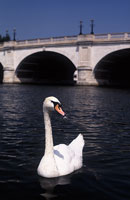 |
| "You look'in at me?!" Swan on the Thames before Kingston Bridge |
Swans are lovely, graceful creatures who normally ignore a kayaker floating in their midst or gently paddling past. They are also very big and powerful. I have never been more impressed by their size than recently when guiding a narrowboat down the Thames outside Reading and witnessing a swan in flight coming up from behind and passing us at cabin level a few feet away: neck outstretched, body the size of a foot stool, wings five-foot across rythmically beating the air. You don't want to stand in the way of a swan.
I was exploring a backwater off the Thames one afternoon when I came across a large cob. He directly began to approach me with beautiful white wings unfurled above. This attention was odd, though, and I instinctively sensed a confrontation, so moved my bow over a touch to block him. He lashed out at the big grey and orange snout of my kayak with a vicous peck and then turned to come round my side. I swung the boat about to block him again, but he arced, swept in and flapped his great wings at me. I began to get a little uneasy, but didn’t want to hurt the bird, so began waving my paddle back and forth over the water. If I could just get a couple of good paddle strokes in to turn the kayak and press downstream, I could leave this agitated swan in peace. But again he surged between the boat and my paddle. This was turning serious; I would be badly disadvantaged if I ended up in the water. I would need to get to shore quickly — probably without the boat, paddle or camera equipment — while simultaneously fending off a seemingly crazed swan hammering away at me.
A woman appeared on the porch of a summer cottage overlooking the backwater and bellowed: “Are you all right? Swans are strong you know, and their wings can break your arm.” This useful piece of information (theoretically possible but, I later discovered, almost unheard of) only served to increase my terror and I resolved to wave the paddle, fully extended, even more menacingly. The swan curved away from the kayak far enough for me to swing the boat round and get in three deep strokes. But with a tremendous flap it rushed me from behind. I leaned forward, ready to duck its beak, and paddled furiously. After a few similar attempts the bird slowed a bit and I was able to put half a dozen boat lengths between us. Unfortunately, when I paused to look back he quickly covered the distance and raised his head for another attack. Eventually I was able to get about 100 yards down the backwater before the swan would take to the air and land with a skid on the water behind me. This threatening behaviour was repeated for almost a quarter mile, until I had been successfully seen off his nesting ground.
Waterproofing Camera Equipment
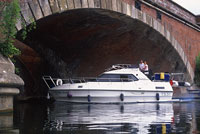 |
| Cruiser passing beneath Brunel"s brick railway bridge at Moulsford |
I keep my camera gear in marine-grade, roll-top waterproof bags sitting on top of the skirt (the ‘upper deck’) clipped to the kayak by a line in the event of disaster. No sense fully protecting Nikon equipment, only to have it float off over a weir! I tend to be methodical in producing images — I often preconceive a subject or scene and possible compositions, then wait for various visual elements (boats, lighting, gestures, etc.) to coincide — so pulling out the gear as and when it is needed suits my photographic style. When working more spontaneously and moving around or chasing a subject, I’ll keep the camera exposed in my lap and simply try not to splash water over it when paddling. I usually use an older ‘second body’ for on-the-river work.
I have looked into waterproof camera housings, but find they are too bulky for kayak use. At the opposite extreme, all the ‘zip-top’ style waterproof camera pouches I have looked at are just not robust enough for heavy use and finicky to use with professional equipment. Even the smallest waterproof briefcase style camera cases — seemingly indestructible — are too bulky to stow in or on the inflatible. Possibly the best of all worlds, at least for my purposes on English rivers, would be a Nikonos set-up, which I am still considering.
The River Thames
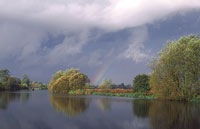 |
| River Thames below Appleford |
It is a common sentiment that the River Thames changes its character at every bend, and it is this which makes it such an interesting river to explore, experience and photograph. I think the river’s character greatly consists in the man-made environment that sits upon its banks, spans it and floats on its surface. 'The Thames' conjures up a host of classic mental pictures: shady stone steps at the river’s edge, lines of lazy willow with a punt moored below, picnics above a grassy bank, half-timbered cottages, Toad Halls, striped lawns, Henley rowers, blazers and Three Men in a Boat. Or, there's the industrial muse: Battersea Power Station looming at dusk, tugs hauling barges, Victorian wharfs. Even the ‘natural’ aspects of the river have been formed and managed for hundreds — even thousands — of years by men and women: the pastures edged by rushes below Cricklade, green meadows, rolling fields of hay and hanging forests of Hart’s Lock Wood. The different river characters we see at every bend of the Thames seem to reflect the human character of those who have lived along those bends over the centuries.
I find the kayak the quietest, smallest and most nimble of craft and one that allows an intimate and human approach to the river and its different characters. It offers great opportunities to create unique and satisfying images and to put some visual form to those classic mental pictures we have of the Thames.
Jim Batty
jimbatty.com
Text and photographs copyright © 2005 by Jim Batty. All rights reserved.
No part of this work may be reproduced, stored in a retrieval system, or transmitted,
in whole or in part, in any form or by any means, without signed written permission
from the author. A standard publishing fee is payable in advance for any editorial
or commercial use.

